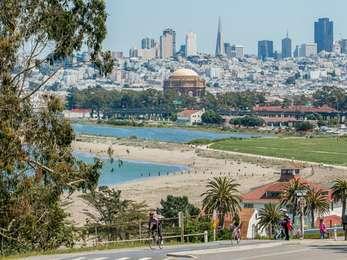Last updated: March 24, 2021
Place
8 - Home of the Yelamu

WAYSIDE PANEL TITLE: Home of the Yelamu
PANEL DESCRIPTION: The wayside faces south west, on the western side of the trail.
VIEW FROM WAYSIDE: From here you can see a fenced-off area around Crissy Field tidal marsh. The area includes a wooden bridge over a shallow body of water with a sandbar protruding at its center. Closer to the fence is a sandy dune dotted by green coastal scrub plants. Much of the dune remains exposed, with a pile of discarded wood lying in the grass.
To the right is a path leading to the San Francisco Bay Trail, which runs east to west. East takes you to East Beach and Crissy Field Center. West takes you to Crissy Field, Fort Point and the Golden Gate Bridge. To the left is a path that leads to picnic tables and barbecues.
TEXT: The Native People of the Peninsula. The Yelamu were one of 50 independent Ohlone tribes related through culture and language. Ohlone peoples have lived in the Bay Area for several thousand years. The Yelamu, whose territory included today's Crissy Field, moved seasonally from the winter villages of Tubsinte, Sitlintac and Petlenuc to the summer/fall villages of Chutchui and Amuctac. Archeological study of remains found at Crissy Field indicates the Yelamu lived here when plants, fish and other animals were available for harvest.
DESCRIPTION OF MAP #1: Small map shows the San Francisco peninsula, labeling Yelamu sites circa 1770. Petlenuc is the furthest north, in the same area as the Presidio, followed by Sitlintac a little south and further east, Chutchui in the center of the peninsula, then Amuctac further south along the eastern coast and further south and inland from there, Tubsinte.
DESCRIPTION OF MAP #2: A larger map showing the entirety of the Ohlone territory circa 1770, an area that stretched from a small area just north of the bay all the way down the coast past Monterey Bay and significantly inland.
QUOTE: "I am very old...my people were once around me like the sands of the shore...many...many. They have all passed away. They have died like the grass...they have gone to the mountains. I do not complain, the antelope falls with the arrow. I had a son. I loved him. When the palefaces came he went away. I do not know where he is. I am a Christian Indian, I am all that is left of my people. I am alone." --Pedro Alcantara, the last known Yelamu, born in 1780, from an interview recorded by Indian Agent Adam Johnston in 1850, the year California became a state.
CHART DESCRIPTION: A two column chart. The first column lists individuals' Yelamu names and their dates of birth. The second column lists the individuals' corresponding Spanish name and the dates of their baptism.
TEXT: Mission San Francisco baptism records reveal the names of some of the last Yelamu individuals from the village of Petlenuc. At baptism the individual was given a Spanish name.
DESCRIPTION OF IMAGE #1: On the left side is a photograph of Ohlone children dancing in a circle wearing traditional regalia including grass skirts, animal pelts and feather headdresses. They're watched by a group of adults and children in modern dress. A man with a goatee wearing a dark shirt and jeans beats a white round drum with a mallet, and looks on as the children dance barefoot on the grass of Crissy Field, overlooking the water's of the bay.
CAPTION: Crissy Field tidal marsh opening, 1999.
TEXT: "We Are Still Here." The Yelamu population, around 200 at the time Spanish colonists arrived in the 1770s, was among the smallest of all Ohlone tribes. The disruptions wrought by European colonization decimated the Yelamu. Although we know of no Yelamu descendants living today, several Ohlone tribal groups and many individuals from the broader Ohlone population make up a vital contemporary native community. Ohlone people have played an active role in the Crissy Field restoration project.
DESCRIPTION OF IMAGE #2: A photograph of several men sitting around a table in a dark room looking on as one man signs a piece of paper on the table.
CAPTION: Ohlone representatives signed an agreement with the National Park Service concerning the preservation and interpretation of Ohlone culture.
TEXT: This exhibit was prepared in collaboration with the Ohlone community. "Ohlone" is a native term used by many tribes and individuals today. Some local tribes, individuals, anthropologists and linguists use the term "Costanoan," which was originally applied to this cultural group by the Spanish.
DIRECTIONS TO NEXT WAYSIDE: Walk 180 feet west along the San Francisco Bay Trail. You'll arrive at a boardwalk bridge where there's a wayside along its northern side.
